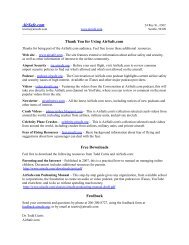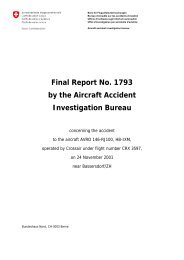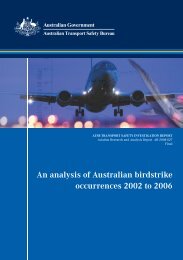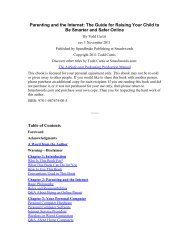AAIB Investigation Updates (PDF) - Airline Safety and Security ...
AAIB Investigation Updates (PDF) - Airline Safety and Security ...
AAIB Investigation Updates (PDF) - Airline Safety and Security ...
You also want an ePaper? Increase the reach of your titles
YUMPU automatically turns print PDFs into web optimized ePapers that Google loves.
<strong>AAIB</strong> Interim Report 2 G-YMMM EW/C2008/01/01<br />
●●<br />
●●<br />
Examination of the melted ice showed that it<br />
consisted of a mixture of water <strong>and</strong> fuel. The<br />
quantity of water in the ice deposited along<br />
the inside of the fuel pipes in the strut area<br />
was greater than the amount found necessary,<br />
in previous tests, to restrict the FOHE.<br />
On two occasions approximately 90 ml of<br />
water was recovered from the ice that had<br />
accumulated in pipes in the strut area. On<br />
another occasion approximately 170 ml of<br />
water was recovered from this area; however,<br />
the possibility that this sample had been<br />
contaminated after the test could not be<br />
excluded.<br />
Ice release tests – cold FOHE 2<br />
Tests were carried out using the environmental test<br />
rig to establish whether increasing the flow rate would<br />
release sufficient ice, that had accumulated on the<br />
inside of the fuel pipes, to cause a restriction at the<br />
face of a FOHE. However, because of the limitations<br />
of the test rig, <strong>and</strong> the apparent ‘r<strong>and</strong>om’ process by<br />
which ice forms, it was not possible to fully replicate<br />
the conditions just prior to the engine rollback on<br />
G‐YMMM.<br />
The first phase of each test was to accumulate ice within<br />
the fuel system using a boost pump to maintain the<br />
fuel flow at 6,000 pph, with the fuel conditioned with<br />
approximately 90 ppm of water <strong>and</strong> maintained at a<br />
temperature of ‐20°C (‐4°F). This was the approximate<br />
fuel temperature at which the rollbacks occurred on<br />
G‐YMMM <strong>and</strong> N862DA. It should be noted that it<br />
was not possible to establish visually how much ice<br />
had accumulated at the end of this phase, without<br />
Footnote<br />
2<br />
A cold FOHE does not have any hot oil flowing through it <strong>and</strong><br />
was used in the tests as a strainer to ‘catch’ any released ice.<br />
compromising the release test. After the accumulation<br />
phase, the fuel flow returning from the end of the strut<br />
was diverted through a cold FOHE <strong>and</strong> the fuel flow<br />
was increased.<br />
In the first test, ice was allowed to accumulate<br />
for 3 hours before the fuel flow was increased to<br />
10,000 pph for 3 minutes; during this test no pressure<br />
drop was detected across the FOHE. On examining the<br />
fuel system no ice was found on the face of the cold<br />
FOHE <strong>and</strong> the amount of ice found on the inside of<br />
the fuel pipes was similar to the amount found during<br />
the previous accumulation tests undertaken at similar<br />
conditions.<br />
In order to increase the flow rate above 10,000 pph it<br />
was necessary to fit an engine LP pump into the flow<br />
path. Under normal operation the LP pump increases<br />
the fuel pressure from around 30 to 200 psig, which<br />
is sufficient to provide a flow rate of approximately<br />
30,000 pph with the control valve fully open.<br />
During the next two tests, ice was allowed to accumulate<br />
for 6 hours before the fuel flow was diverted to the LP<br />
pump <strong>and</strong> cold FOHE. The fuel flow was increased by<br />
progressively opening the control valve during which,<br />
on both tests, the pressure drop across the FOHE<br />
increased <strong>and</strong> the LP pump outlet pressure reduced. In<br />
the first of these tests, as the control valve was gradually<br />
moved fully open, the pressure drop across the FOHE<br />
began to increase 3 when the fuel flow was between<br />
6,000 <strong>and</strong> 10,000 pph, indicating that ice had released<br />
<strong>and</strong> started to form a restriction at the FOHE. The fuel<br />
flow became restricted to 14,500 pph before decreasing<br />
to 11,000 pph, with a corresponding pressure drop of<br />
Footnote<br />
3<br />
In normal operation the differential pressure across the FOHE<br />
increases slightly with increasing fuel flow. In these tests the pressure<br />
differential was higher than would be expected in normal operation.<br />
© Crown copyright 2009<br />
5











